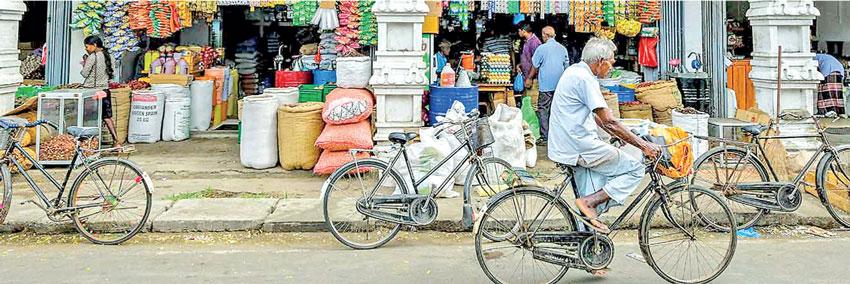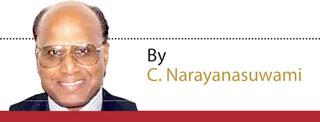28 Mar 2023 - {{hitsCtrl.values.hits}}
 It was interesting to observe that proficiency in the Sinhala language among Tamil traders was even better than their counterparts in Colombo
It was interesting to observe that proficiency in the Sinhala language among Tamil traders was even better than their counterparts in Colombo
 The recent visit to Jaffna, after several years of forbidden travel due to the pandemic, provided an opportunity to revisit areas of interest and observe the changes, including positive and negative developments, in both the economic and social fronts. It was a quick visit and unexpectedly the timing of the visit coincided with the visit of the President who declared open the Jaffna Cultural Centre on 11 February 2023. The festive atmosphere that prevailed on that day was combined with a subdued celebration of the 75th anniversary of Sri Lanka’s Independence. The atmosphere signified that Jaffna is slowly emerging from the isolation that kept its charms hidden.
The recent visit to Jaffna, after several years of forbidden travel due to the pandemic, provided an opportunity to revisit areas of interest and observe the changes, including positive and negative developments, in both the economic and social fronts. It was a quick visit and unexpectedly the timing of the visit coincided with the visit of the President who declared open the Jaffna Cultural Centre on 11 February 2023. The festive atmosphere that prevailed on that day was combined with a subdued celebration of the 75th anniversary of Sri Lanka’s Independence. The atmosphere signified that Jaffna is slowly emerging from the isolation that kept its charms hidden.
Except for the cleaning up and beautification of Aryakulam and its environs with a benefactor’s contribution, the Jaffna Municipal Council does not appear to have initiated any significant renovation and refurbishment work in public areas
Economic Activities
The war-torn city of Jaffna is coming back to life after almost three decades and three years of the pandemic while struggling to cope with day-to-day cost of living pressures and erosion of well entrenched societal values. One could witness the disappearance of bullet marked buildings which are being renovated with remittances received from overseas.
The end of the war saw significant road development initiatives sponsored by the central government. This resulted in paved roads including the major artery-A9-and other pivotal highways that connect Kankesanthurai, Palaly and Point Pedro. Unfortunately, some areas did not benefit from this uneven development. For example, the road leading to some of the main Islands like Velanai,Pungudutivu and Nainathivu is in a dire state requiring immediate attention. There could be similar situations elsewhere not traversed by the author.
Renovation of old houses and temples, and establishment of small businesses appear to have occurred during the pandemic. The emergence of supermarkets combined with a surfeit of wedding halls give the impression that there was money circulating in the community despite lack of evidence of enhanced economic activity-remittances from abroad have been used to reconstruct damaged houses and buildings as well as invest in some less productive ventures. Anecdotal evidence suggests that most of the wedding halls will soon be white elephants!
While construction activities proceeded on a small scale with private funding, public places like the Jaffna market and Tinnevely market areas remained largely untouched. Except for the cleaning up and beautification of Aryakulam and its environs with a benefactor’s contribution, the Jaffna Municipal Council does not appear to have initiated any significant renovation and refurbishment work in public areas. The development of the Aryakulam area into a place of both historical and touristic attraction is a welcome move, but may require further investments to enhance its potential.
In a city where the primary mode of transport was bicycles, the growth in the number of scooters signified that overseas remittances were occasionally put to good use despite contradictions in the way funds were invested. The Jaffna youth considered the possession of scooters as a status symbol in addition to its practical value as a transportation mode. This has also helped older adults to be less dependent on public transport to get to work and attend to household activities.
In anticipation of an influx of tourists, increased number of medium sized hotels and resorts and a plethora of guesthouses have sprung up in the last few years. Many of the guesthouses remain empty although hotel occupancy rates are improving with south-north traffic and a sprinkling of overseas tourists.
An interesting development is taking place consequent to the removal of border controls. The movement of Sinhalese from the south has increased considerably and their involvement in some economic activities has created an opportunity for increased social interaction with the Tamils. A substantial number of people travel from the south to visit religious places in Nagadeepa/Nainatheevu and other areas of social interest. The number of visitors from the south outnumbered those from within Jaffna on the day the author visited Keerimalai Springs, a place noted for its religious significance and healing properties. Another event comes to mind-the author witnessed a busload of visitors from the south entering the Jaffna market after visiting Sri Naga Vihara and negotiating prices for products in Sinhala. It was interesting to observe that proficiency in the Sinhala language among Tamil traders was even better than their counterparts in Colombo. This situation raises hopes that movement of people irrespective of their race, religion or caste will now promote unity in diversity and greater interaction among the country’s diverse population.
The involvement of Sinhalese in some economic activities has created an opportunity for increased social interaction with the Tamils
The social structure is reported to be crumbling. The social stratification that encompassed caste-based divisions which continued to survive the onslaught of the civil war is now co-existing with clan- based divisions resulting in sharp deterioration in the social order. The emergence of gangs engaged in criminal activities using sword as a weapon combined with indiscriminate use of drugs among the youth have created a divisive population.
In contrast to this development however, a substantial number of youth pursuing higher studies have shown keenness in their studies. What was gratifying were the scenes witnessed in many roadside areas where queues of students in bicycles were waiting for their turn to attend tuition classes. The difference was that such students were always accompanied by one of their parents compared to what prevailed a decade or two ago when the same practice of attending tuition classes rested entirely with the students themselves. This sharp difference has apparently arisen due to the fear that unaccompanied students would fall a prey to drug use and other socially disruptive practices.
An assessment
Is Jaffna booming, blooming or busting is the question that arises in the minds of those familiar with Jaffna’s heritage, historical background, culture and socioeconomic development patterns. Jaffna is going through a process of transformation which displays both positive and negative features. The author, in his book entitled, ‘ManagingDevelopment: People, Policies, and Institutions’ launched in Colombo under the auspices of the current President (then Prime Minister) in August 2019 and later in Sydney, Australia in September 2019, and in Manila, Philippines in November 2019 had this to say about development, “Development is about people. People are both partners and beneficiaries of change. Good policies and effective institutions provide the basis for sound development management. Successful institutions derive their power from competent leaders and good management practices. The pace and process of development are determined by good governance and strengthened capacity to implement and manage projects”. Viewed from this perspective there are shortfalls and issues relating to policies, appropriate institutional structure and oversight and sound governance, including dynamic leadership and management, providing form and content to structured development at the local level.
Regaining confidence in the stability of life which had been badly battered during the civil war and subsequent post-war period could be considered a significant positive feature. Although the pandemic had an adverse impact on agricultural activities there was progressive participation in pursuits that kept people engaged in productive occupations. At present farming activities are slowly building up though not to the levels of the pre-war situation.
Non-farm activities comprised opening of small-scale grocery stores, supermarkets, fisheries and general business ventures and mixed trading enterprises, including tourism related ventures. Supermarkets and agro-industrial enterprises such as mills, and packaging industries have generated some employment among the youth.
Infrastructure development, one of the key features of post war development, has had both positive and negative impacts due to uneven spread and lack of adoption of a strategic planning approach.
Education has been identified as an industry in the Jaffna peninsula from the time of the British and continues to be so even now although standardisation of university admissions in the 1970s caused a substantial setback. However, the level of interest in pursuing higher studies is evident in the keenness shown by students to follow tuition classes despite obstacles.
The participation of people from the south in economic activities has brought the Sinhala-Tamil communities together and with or without their knowledge they are promoting inter-communal harmony and social integration.
The primary limiting factor is the lack of a planned investment pattern, both public and private, that has resulted in uneven and lopsided development which has contributed to unproductive ventures mushrooming in several parts of the city. This was confirmed by many, including legislators who understand the pulse of the people better. Some of the supermarkets located in distant areas were reported to be on the verge of closing due to lack of business. The practicality and sustainability of these ventures were not subjected to critical examination at the planning stage. The same applies to guesthouses many of which have had no guests for months.
Another limiting factor is the drug menace which seems to attract the marginalised youth who, having suffered from the trauma, loss of life and poverty during and after the war, found an escape route provided by unscrupulous and influential drug traffickers.
Conclusions
Jaffna is moving forward and is witnessing a positive transformation, albeit with limitations arising from ill-planned, adhoc and disjointed interventions spanning the entire development domain. The absence of investments in any major industrial venture suggests that long-term investment planning has been missing. A distinguishing feature of the development pattern is that investment funds came largely from overseas remittances with no significant inputs from successful local entrepreneurs or from local government institutions. This needs to be reversed and funds should be generated within the country at central and local levels if the pattern of investment is to be directed at ventures that will have a durable impact on the society with their economic and social viability assessed and analysed critically at the planning stage. This however does not preclude external financing provided it is channelled appropriately.
There needs to be a centrally located planning entity or a technically competent approval body which could coordinate the approval, supervision and monitoring of new ventures based on their relevance and economic value. An overarching body of this nature could possibly fall under varying authority levels depending on the scope, nature, and size of the investment portfolio; under the district secretariat, the Governor or the Jaffna Municipal Council, as appropriate.
The social issues, including drug trafficking, need to be tackled with appropriate intervention, supervision and funding from both central and local government levels. The establishment of an effective, high level task force comprising representatives from civil, military, police and NGO’s to handle crime and drug use could play a pivotal role to apprehend offenders, seek appropriate punishments, and enforce rehabilitation activities endorsed by medical and social welfare institutions.
(The writer is formerly of the Ceylon Civil Service and Retired Senior Professional of the Asian Development Bank)
06 Jan 2025 2 hours ago
06 Jan 2025 3 hours ago
06 Jan 2025 3 hours ago
06 Jan 2025 3 hours ago
06 Jan 2025 3 hours ago